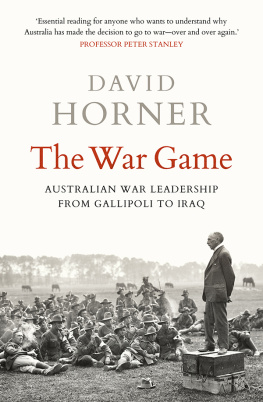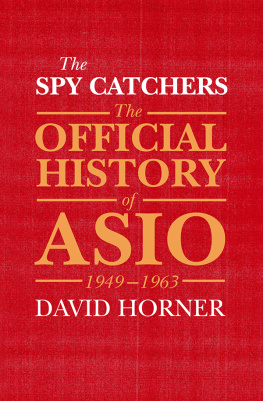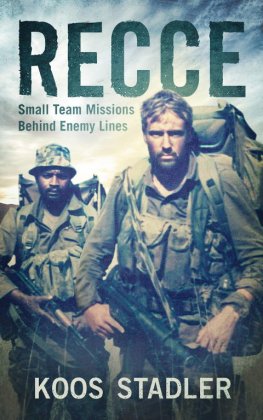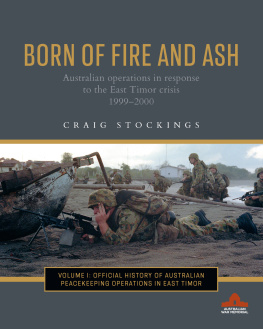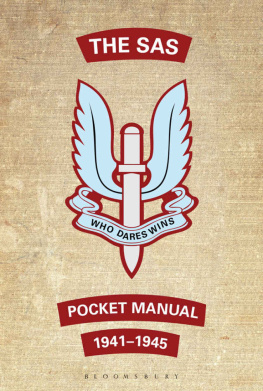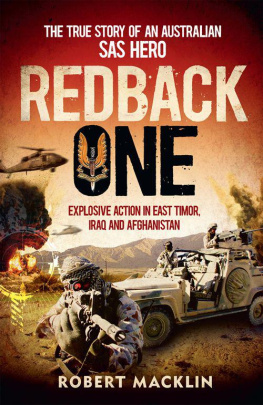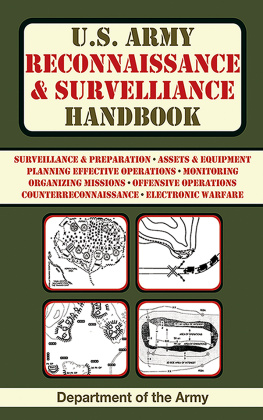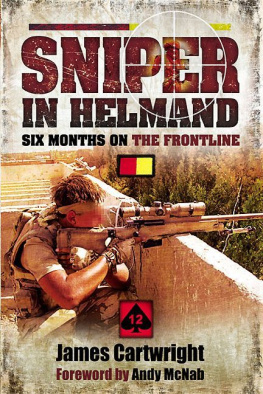IN ACTION
WITH THE
SAS
DAVID HORNER is Professor of Australian Defence History in the Strategic and Defence Studies Centre, Australian National University. A graduate of the Royal Military College, Duntroon, he served as an infantry platoon commander in South Vietnam and has had many years of regimental and staff experience. In 1998, as an Army Reserve colonel, he became the first head of the Armys Land Warfare Studies Centre. He has written numerous books on military command, operations, defence policy and strategy, including Defence Supremo, Blamey: The Commander-in-Chief and Breaking the Codes (co-authored with Desmond Ball).
In 2004 he was appointed Official Historian of Australian Peacekeeping and Post-Cold War Operations.
IN ACTION
WITH THE
SAS
Updated edition of
SAS: Phantoms of the Jungle
DAVID HORNER

First published as SAS: Phantoms of the Jungle in 1989
Second edition published as SAS: Phantoms of War in 2002
This revised and updated edition published in 2009
Copyright David Horner 1989, 2002, 2009
All rights reserved. No part of this book may be reproduced or transmitted in any form or by any means, electronic or mechanical, including photocopying, recording or by any information storage and retrieval system, without prior permission in writing from the publisher. The Australian Copyright Act 1968 (the Act) allows a maximum of one chapter or 10 per cent of this book, whichever is the greater, to be photocopied by any educational institution for its educational purposes provided that the educational institution (or body that administers it) has given a remuneration notice to Copyright Agency Limited (CAL) under the Act.
Allen & Unwin
83 Alexander Street
Crows Nest NSW 2065
Australia
Phone: (61 2) 8425 0100
Fax: (61 2) 9906 2218
Email: info@allenandunwin.com
Web: www.allenandunwin.com
National Library of Australia
Cataloguing-in-Publication entry:
National Library of Australia Cataloguing-in-Publication entry
Horner, D. M. (David Murray), 1948
In action with the SAS.
ISBN: 9781741755527 (pbk.)
Includes bibliographical references and index.
Australia. Army. Special Air Service RegimentHistory.
Australia. ArmyCommando troops.
Other Authors/Contributors:
Thomas, Neil.
Also Titled: In action with the Special Air Service
356.1670994
Index by Trevor Matthews
Set in AIProspera Book 12/16 pt by Midland Typesetters, Australia
Printed in Singapore by KHL Printing Co Pty Ltd
10 9 8 7 6 5 4 3 2 1
CONTENTS
MAPS
Map 1: SABAH, SARAWAK AND BRUNEI
This map shows the two areas where the SAS served in Borneo. 1 SAS Squadron generally operated in the area marked as Map 2, while 2 SAS Squadron operated in the area marked as Map 3 in 1966.
Map 2: BORDER AREA: SABAH, SARAWAK, KALIMANTAN
This map shows the area where 1 SAS Squadron generally operated in 1965. The area along the border between Kalimantan and Sarawak and Sabah consisted of a tangle of steep mountains separated by numerous rivers, and was covered by thick jungle. Maps were unreliable and it was difficult to know when the border had been crossed.
Map 3: BORDER AREA: FIRST DIVISION, SARAWAK
This map shows the area where 2 SAS Squadron operated in 1966. The border was usually along a jungle-covered ridge leading down to rivers, which were the main means of communication in this area of Kalimantan. The Sarawak side consisted of jungle with small cultivated areas around the kampongs.
Map 4: CORPS AREA SOUTH VIETNAM
This map shows the location of Phuoc Tuy Province in relation to the remainder of South Vietnam.
Map 5: PHUOC TUY PROVINCE
From 1966 to 1971 the Australian SAS Squadron was based at Nui Dat and operated in the area covered by this map. Missions were conducted throughout Phuoc Tuy Province and across the border into Bien Hoa, Long Khanh and Binh Tuy provinces. The border and mountain areas were generally covered with extensive areas of jungle, while the areas around the villages and towns were usually cultivated, either with rice or rubber plantations.
Map 6: EAST TIMOR
In September 1999 the 3 SAS Squadron group was deployed to East Timor, and was based at Dili. It conducted operations throughout the territory, but mainly in the western areas, until replaced by 1 SAS Squadron in December 1999.
PREFACE
In Action with the SAS is the third edition of my history of the Australian Special Air Service Regiment, first published in 1989. The first edition, SAS: Phantoms of the Jungle, set out to describe the operations of the Special Air Service from its establishment in 1957 through to 1989. I had been asked to write the book by the then Director of Special Action Forces, Colonel Rod Curtis, who believed that the history of the regiment needed to be written while its early members were still alive. He also believed that the actions of the SAS in Borneo and Vietnam, which until then had been secret, needed to be put on the public record. Accordingly, in writing the history I was given full access to all the SAS Regiments records and was able to interview a large number of serving and ex-SAS soldiers who had served in the regiment at home and on active service. I examined almost 1400 patrol reports, which needed to have their security classification downgraded so that they could be used in the book. The two commanding officers of the regiment at the time, Lieutenant-Colonels Terry Nolan and Jim Wallace, placed the full resources of the regiment at my disposal.
The second edition of the book was published in 2002 with the title SAS: Phantoms of War. As I noted then, in the thirteen years since the initial publication the Australian SAS had seen momentous changes, with the development of new capabilities within the regiment and its involvement in numerous operations, including deployments on peace operations during the 1990s, culminating in the INTERFET operation in East Timor in 19992000.
For the new edition I deleted the old final chapter, replacing it with two new chapters covering the more recent period. Considering the wide range of activities carried out by the regiment in that time it was not possible to describe them in the same depth as in the original account. Further, details of some recent activities could not be published at that stage. Nor, for security reasons, was it possible to mention the names of as many individual soldiers as was the case in the earlier account. The story that emerged, however, showed how the regiment had outgrown the Vietnam legacy and had secured its place as the Australian Defence Forces force of choice. The book remained, therefore, as a comprehensive account of the regiments service during a period of more than 40 years.
As with the earlier edition, I had the full support of the commanding officer during 19992000, Lieutenant-Colonel Tim McOwan, who gave me access to unit files and facilitated interviews with serving unit members. Brigadiers Philip McNamara and Duncan Lewis, successive Commanders Special Forces, cleared the way for the project.
This new edition, In Action with the SAS, tells the same story (1957 to 2000) as the earlier editions, but has been edited, with the assistance of Neil Thomas, to make it more accessible to a new readership. It was tempting to try to bring the SAS story up to the present, but the major campaigns in which the SAS has been involvedAfghanistan and Iraq are still being fought. It is not yet possible to examine the full documentary record, and details of the operations cannot be released while they are still proceeding. It would also be difficult to tell the full story of the SAS in Afghanistan and Iraq without reference to the actions of other Australian and coalition forces. This would require a treatment that would not fit easily into a mere extension of the present history.
Next page




